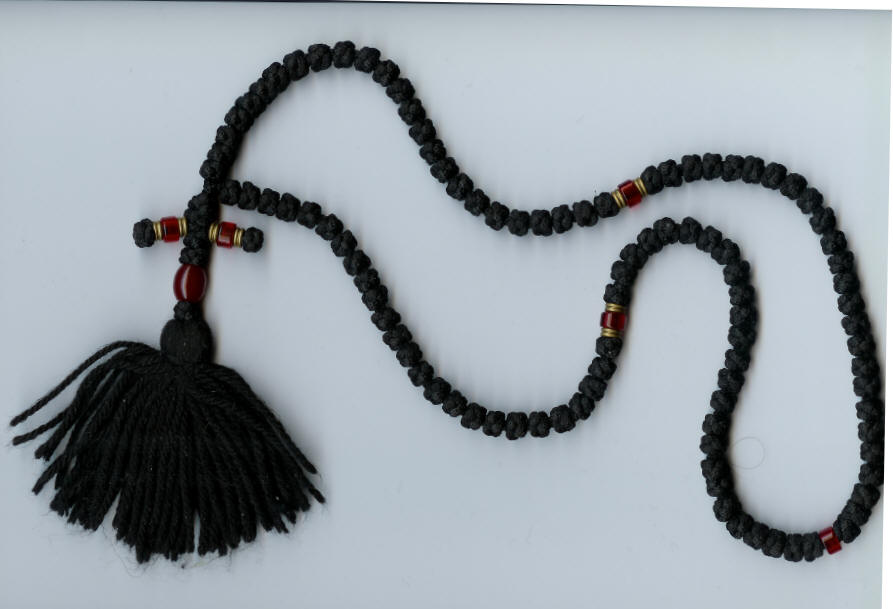Many of the Orthodox Christians piously wear at their hands a
"bracelet" made of wool knots or wooden beads. Fewer however know its
true significance. The first thing we should stress is that it is not a
piece of jewelry but an actual prayer rope. Its purpose is not just as
decoration or to show others we are Orthodox, as many believe, but to be
used as an aid in accomplishing our daily prayers.

 The use of the prayer ropes is ancient
in itself, going back to the origins of Christian monasticism. The
prayer rope, creation attributed to Saint Pachomius in the fourth
century, was intended as an aid for monks that could not read to
accomplish a consistent number of prayers and prostrations in their
cells. The use of the rope made it possible to pray the Jesus Prayer
unceasingly, whether inside the cell or out, in accordance with Saint
Paul's injunction to "Pray without ceasing" (I Thessalonians 5:17).
The use of the prayer ropes is ancient
in itself, going back to the origins of Christian monasticism. The
prayer rope, creation attributed to Saint Pachomius in the fourth
century, was intended as an aid for monks that could not read to
accomplish a consistent number of prayers and prostrations in their
cells. The use of the rope made it possible to pray the Jesus Prayer
unceasingly, whether inside the cell or out, in accordance with Saint
Paul's injunction to "Pray without ceasing" (I Thessalonians 5:17).
The method of tying the prayer rope also
goes back to the fathers of monasticism. Saint Anthony the Great it is
said to have started by tying a leather rope with a simple knot for
every time he prayed Kyrie Eleison ("Lord have Mercy"), but the Devil
would come and untie the knots to throw off his count. He then devised a
way--inspired by a vision he had of the Theotokos--of tying the knots
so that the knots themselves would constantly make the sign of the
cross. This is why prayer ropes today are still tied using knots that
each contain seven little crosses being tied over and over. The Devil
could not untie it because the Devil is vanquished by the Sign of the
Cross.
The prayer ropes are not to be confused
with worry beads used as a pass-timer or calming device. The prayer ropes
are to be used only in prayer. They come in various shapes and sizes
but always they have a fixed number of knots or beads. This can be 33
(for the normal "bracelets") or 40, 50, 100, 200, 300, etc. for the
longer ropes.

The use of the Jesus prayer with
prostrations is sanctioned by our Church, which directs that one can (in
cases of need) replace the common worship services with a definite
number of prostrations and the Jesus Prayer (which would be difficult to
carry out without the rope). Here is a guide we find at the end of some
Psalter books.
Instead of the entire Psalter: 6000 Jesus Prayers
One kathisma: 300 prayers; for each stasis: 100
Midnight Service: 600
Matins: 1500
Vespers: 600
Great Compline: 700
Small Compline: 400
An Akathist to the Blessed Theotokos: 500
One kathisma: 300 prayers; for each stasis: 100
Midnight Service: 600
Matins: 1500
Vespers: 600
Great Compline: 700
Small Compline: 400
An Akathist to the Blessed Theotokos: 500
All those who are zealous for their
salvation are invited to this unceasing remembrance of the saving name
of Jesus, both laymen and monastics, for the spirit of life in Christ is
one and the same for both. Many of our spiritual elders, men of prayer,
ascetics and directors in faith and piety, down to the most recent time
have recommended the use of the prayer rope to laymen and at times have
even given them their own prayer ropes as a blessing.
For this reason we also recommend to the
lay people today to properly use the prayer ropes around their hands to
pray wherever they are, at home, at work, or driving, with a simple
prayer: "Lord Jesus Christ Son of God have mercy on me the sinner" or
simply "Lord Jesus Christ have mercy on me".

No comments:
Post a Comment